Uncategorized
U.N. exhibit remembers when the world turned its back on stateless Jewish refugees
(New York Jewish Week) — In 2017, Deborah Veach went back to Germany, looking for the site of the displaced persons camp where she and her parents had been housed after World War II. They were in suspension, between the lives her parents led in Belarus before they were shattered by the Nazis, and the unknown fate awaiting them as refugees without a country.
To her dismay, and despite the fact that Foehrenwald was one of the largest Jewish DP centers in the American-controlled zone of Germany, she found barely a trace. A complex that once included a yeshiva, a police force, a fire brigade, a youth home, a theater, a post office and a hospital was remembered by almost no one except a local woman who ran a museum in a former bath house.
“It was sort of an accident of history that we were there in that particular camp in Germany, of all places, with no ties, no extended family, no place to call home,” said Veach, who was born at Foehrenwald in 1949 and lives in New Jersey. Now, “they renamed it. They changed the names of all the streets. There is nothing recognizable about the fact that it had been a DP camp.”
Veach is part of a now-aging cohort of children born or raised in the DP camps, the last with a first-hand connection to the experience of some 250,000 Jewish survivors who passed through them at the end of the war. To make sure memories of the camps survive them, the YIVO Institute for Jewish Research and the United Nations Department of Global Communications have staged a short-term exhibit, “After the End of the World: Displaced Persons and Displaced Persons Camps.”
On display at U.N. headquarters in New York City Jan. 10 through Feb. 23, it is intended to illuminate “how the impact of the Holocaust continued to be felt after the Second World War ended and the courage and resilience of those that survived in their efforts to rebuild their lives despite having lost everything,” according to a press release.
Residents of a displaced persons camp in Salzburg, Austria. Undated, post-Second World War. (YIVO Institute for Jewish Research)
Among the artifacts on display are dolls created by Jewish children and copies of some of the 70-odd newspapers published by residents, as well as photographs of weddings, theatrical performances, sporting events and classroom lessons.
The exhibit is “about the displaced persons themselves, about their lives and their hopes and their dreams, their ambitions, their initiatives,” said Debórah Dwork, who directs the Center for the Study of the Holocaust, Genocide, and Crimes Against Humanity at the Graduate Center-CUNY, who served as the scholar adviser for the exhibition.
“There’s no point where the residents of these DP camps were just sitting around waiting for other people to do things for them,” she told the New York Jewish Week. “They took initiative and developed a whole range of cultural and educational programs.”
As early as 1943, as the war displaced millions of people, dozens of nations came to Washington and signed onto the United Nations Relief and Rehabilitation Authority. (Despite its name, it preceded the founding of the U.N.) After the war, the British and U.S. military were in charge of supplying food, protection and medical care in hundreds of camps throughout Germany and Austria, and UNRRA administered the camps on a day-to-day basis.
Early on, Jewish Holocaust survivors — some who suffered in concentration camps, others who had escaped into the Soviet Union — were put in DP camps alongside their former tormentors, until the U.S. agreed to place them in separate compounds. Unable or unwilling to return to the countries where they had lost relatives, property and any semblance of a normal life, they began a waiting game, as few countries, including the United States, were willing to take them in, and Palestine was being blockaded by the British.
Abiding antisemitism was not the only reason they remained stateless. “Jews were [accused of being] subversives, communists, rebels, troublemakers, and the world war quickly gave way to cold war, and with it the notion that Hitler had been defeated and what we have to worry about is the communists,” David Nasaw, author of “The Last Million,” a history of the displaced persons, told the New York Jewish week in 2020.
In 1948 and 1950, Congress grudgingly passed legislation that allowed 50,000 Jewish survivors and their children to come to the United States. The rest were eventually able to go to Israel, after its independence in 1948.
The U.N. exhibit focuses less on this macro history — which includes what became another refugee crisis for the Palestinians displaced by Israel’s War for Independence — than on life in the DP camps.
“The exhibition illustrates how the displaced persons did not shrink from the task of rebuilding both their own lives and Jewish communal life,” said Jonathan Brent, chief executive officer at YIVO, in a statement.
Among those rebuilding their lives were Max Gitter and his parents, Polish Jews who had the perverse good luck of being exiled to Siberia during the war. The family made its way to Samarkand, in Uzbekistan, where Gitter was born in 1943. After the war ended, his parents returned to Poland, but repelled by antisemitism sought refuge in the American zone in Germany. They spent time in the Ainring DP camp, a former Luftwaffe base on the Austrian border, and at a small camp called Lechfeld, about 25 miles west of Munich.
Dolls made by stateless Jewish children residing in a DP camp near Florence, Italy, known as “Kibbutz HaOved.” The dolls are attired in local costumes based on the districts of the Tuscan city of Sienna. (YIVO Institute for Jewish Research)
“I was there until we came to the United States when I was six and a half, so I have some very distinct memories and some hazy memories,” said Gitter, emeritus director and vice chair of the YIVO board. One story he hasn’t forgotten is how his father and a friend were walking through the camp when they came upon a long line of people. “They were from the Soviet Union, so they knew that when there’s a line that it might be of interest.” It turned out to be a line for the lottery that would allow them to get into the United States under the Displaced Persons Act of 1948.
The family came to the United States in 1950, to “pretty shabby lodgings” in the Bronx, before his father bought a candy store and moved to Queens. Max went on to attend Harvard College and Yale Law School, and became a corporate litigator.
Gitter’s brother was born in one of the camps, and the exhibit includes a poster depicting the population increase between 1946 and 1947 at the Jewish DP center Bad Reichenhall. The birthrate in the camps has often been described as evidence of the optimism and defiance of the survivors, but Dwork said the truth is somewhat more complicated.
“There was a very high birth rate among the Jews in DP camps. This is the age group of reproductive age, at 20 to 40,” she said. “However, this image of fecundity hides what was rumored to be a significant abortion rate, too. And women had experienced years of starvation. Menstruation had only recently recommenced. So many women, in fact, miscarried or had trouble conceiving to begin with.”
A chart by artist O. Lec depicts the natural population increase of the Jewish Center Bad Reichenhall, Germany, 1946-1947. There was a very high birth rate among the Jews in DP camps. (YIVO Institute for Jewish Research)
“There is no silver lining here,” she added. “People live life on many levels. On the one hand, DPs look to the future and look with hope; at the same time, they carry tremendous burdens of pain and suffering and trauma and trepidations about the future.”
Veach, a member of the YIVO board, hopes visitors to the exhibit understand that such trauma is hardly a thing of the past.
“I think the real lesson is that history keeps repeating itself,” said Veach, growing emotional. “Basically we have DPs on our border with Mexico, you have DPs from Ukraine. I don’t think people realize the repercussions for these people who are trying to find a place to live. These are good people who are just placed where they are by history.”
Gitter, who like Veach will speak at an event Jan. 24 at the U.N. marking the exhibit, also hopes “After the End of the World” prods the consciences of visitors.
“A lot of the countries, a lot of places, including the United States, would not accept Jews after the war,” he said. “The issue of memory, the issue of statelessness, the issue of finally there was some hope for the Jews in their immigration to Israel and the United States — that part of the story also needs to be told.”
“After the End of the World: Displaced Persons and Displaced Persons Camps” is on view from Jan. 10-Feb. 23, 2023, at the United Nations Headquarters, 405 E 42nd St, New York, Monday-Friday, 9:00 a.m.-5:00 p.m. Entrance to the United Nations Visitor Centre in New York is free, but there are requirements for all visitors. See the United Nations Visitor Centre entry guidelines.
—
The post U.N. exhibit remembers when the world turned its back on stateless Jewish refugees appeared first on Jewish Telegraphic Agency.
Uncategorized
A Jewish lawyer sued Henry Ford and changed how we think about hate speech
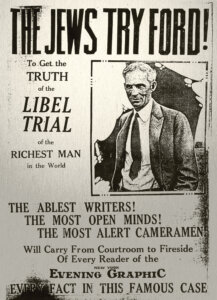
When Jewish lawyer and labor leader Aaron Sapiro sued Henry Ford for libel, he was doing more than trying to save his own reputation. Described by Jewish history professor James Loeffler as “the first modern hate speech trial in America,” the case disrupted Ford’s ability to publish antisemitic conspiracies in his paper The Dearborn Independent.
Sapiro took Ford to court in 1925 for publishing 21 articles attacking him as a “globalist” Jew trying to take over the agriculture industry. In the documentary Sapiro v. Ford: The Jew Who Sued Henry Ford, directors Carol King and Gaylen Ross explore the case through archival materials, interviews with historians, and Sapiro’s own writings, recited by actor Ben Shenkman.
“It’s a David and Goliath story,” King said in an interview. “He took on the most powerful, richest man in America at the time.”
The Dearborn Independent was once the second largest circulating newspaper in America, spreading Ford’s antisemitic theories across the country. The legacy of his antisemitism was so strong that Ross’ “family never had a Ford car” when she was growing up in the 1950s. King is not Jewish but was raised in Detroit, where Ford’s company was headquartered. She said his antisemitism “was always talked about as sort of a quirk.”
Sapiro himself didn’t understand the gravity of Ford’s words at first.
“He thought, ‘Who’s gonna believe that stuff? It’s so outrageous,’” King said. “As it turns out, a lot of people did believe it.”
King remembered Ford’s “weird ideas” such as that baseball and jazz were rotting American society — and he blamed their popularity on the Jews. His words had a global impact: Hitler praised Ford in Mein Kampf and, at the Nuremberg trials, Baldur von Schirach, former head of the Hitler Youth, credited Ford with inspiring his own antisemitism.
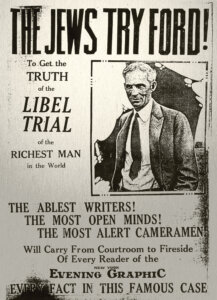
When Jewish merchants told Sapiro that Ford’s articles were driving away their customers, Sapiro realized he had to try to stop the conspiracies.
“This was one person who stood up, not just for himself, that was important, but also for his community, for his fellow Jewish people,” King said.
King started working on the film over a decade ago with her husband Michael Rose, a filmmaker who provided archival material for Michael Moore’s Roger & Me and worked on the documentary Who Killed Vincent Chin? They spent ten years researching the Sapiro case and gathering archival materials, but when Rose became sick with leukemia, the project went on indefinite hiatus. He passed away in September of 2020.
Before he died, he had shown Ross, known for her documentary Killing Kasztner, an extended trailer for the project. Ross later offered to help King complete the film.
“How could I say no? It was a gift to me at a time when I needed something badly,” said King.
Ross was particularly interested in making Sapiro’s story more widely known.
“Sapiro, in the Jewish canon, didn’t exist,” Ross said. “He was essentially erased.”
Born to a poor family in San Francisco in 1884, Sapiro survived being abandoned in an orphanage and overcame financial hardship to eventually graduate from the University of Cincinnati College of Law. He worked with the National Farmers Union and introduced a new method of agricultural unionizing that allowed farmers to pool their resources and have collective market power.
Because the Model T had also revolutionized farming, Ford saw himself as the champion of the American farmer and was alarmed by Sapiro’s sudden influence. He was particularly troubled by Sapiro’s visits to farmers in Canada.
“Sapiro could organize farmers and cooperatives all over the country,” Ross said. “But crossing the border made him an example of international Jewry and the conspiracy that Ford believed in.”
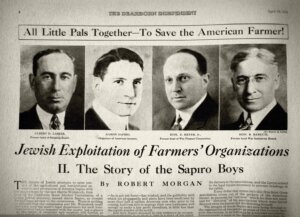
The film brings Sapiro to life using Shenkmen to recite his speeches and writings, although it omits some aspects of his life, such as his association with Al Capone that made him the subject of trade racket investigations in Chicago.
Ross and King say Sapiro’s story has implications for understanding modern hate speech. An opening montage of antisemitic headlines from the 1920s — “The Jewish Control of the American Press,” “Jews Are The Curse Of America” — is promptly followed by footage from recent neo-Nazi and white supremacist rallies, offering a warning about what happens when bigotry goes unchecked.
“Not only was he prophetic in worrying about what would happen in a society that condemned not only the Jewish community, but people who were different and refugees,” Ross said of Sapiro. “But his focus on democracy — and he says it strongly — that democracy is not just about politics; it’s about how you live your life and how you collaborate and work together.”
Sapiro v. Ford: The Jew Who Sued Henry Ford is showing at the New York Jewish Film Festival starting on January 21 and the Palm Beach Jewish Film Festival starting on Jan. 29.
The post A Jewish lawyer sued Henry Ford and changed how we think about hate speech appeared first on The Forward.
Uncategorized
British Jews could be offered asylum in the US, Trump’s UK-born Jewish lawyer says
(JTA) — The Trump administration might be considering granting asylum to British Jews, according to Trump’s personal lawyer, who said “the UK is no longer a safe place for Jews.”
Robert Garson, a Jewish attorney from Manchester, England, with rising influence in the Trump administration, said he proposed the move to the State Department in an interview with The Telegraph.
Garson said his proposal was well received despite the Trump administration’s general anti-immigration stance.
“I thought: Jews are being persecuted in the United Kingdom,” Garson said. “They fit a wonderful demographic for the United States. They are, on the whole, educated. They speak English natively. They’ve got businesses. They’re exactly the sort of immigrant the United States should want to attract. So, why not?”
Garson said his views on the future of Jews in Britain hardened after the terror attack on a synagogue in his hometown last year. Two people were killed at the Heaton Park Hebrew Congregation on Yom Kippur after a man rammed his car into a crowd of people and stabbed others.
In October, the White House announced that it would restrict the number of refugees admitted to the United States to 7,500 in 2026, mostly reserving those spots for white South Africans. The number represents a steep drop from former President Joe Biden’s ceiling of 125,000 in 2024.
The administration’s privileging of white South Africans has been widely criticized in South Africa, including by Jews. The country’s chief rabbi Warren Goldstein, otherwise a vocal Trump supporter, called the move a “mistake.”
Garson was hired by Trump in 2022 to sue investigative journalist Bob Woodward for $50 million over Woodward’s publication of Trump interviews in an audiobook. (The lawsuit was dismissed in July.) Donald Trump Jr. has also hired Garson as a lawyer for his publishing house, Winning Team Publishing, which has published the president, Charlie Kirk and other prominent conservatives.
Garson’s rise continued with an appointment to the United States Holocaust Memorial Council in May. He was among several Trump allies that the president named to replace members appointed by Biden, including Doug Emhoff, the Jewish husband of former Vice President Kamala Harris.
White House press secretary Karoline Leavitt said at the time, “President Trump looks forward to appointing new individuals who will not only continue to honor the memory of those who perished in the Holocaust, but who are also steadfast supporters of the State of Israel.”
Garson moved to New York in 2008 and now lives in Florida, where he is the head of armed security at his synagogue. After the Hamas attack on Israel on Oct. 7, 2023, Garson became a National Rifle Association-licensed instructor and has offered to train any Jews who are interested.
He believes that “if there had been 6 million guns in 6 million Jewish hands, there would have been 6 million fewer deaths” in the Holocaust, he told The Telegraph.
Garson laid much of the blame for dangers to British Jews at the foot of Prime Minister Keir Starmer, saying that he “allowed rampant antisemitism to become commonplace in society and has allowed it to come from those who really don’t have Britain’s best interests at heart.”
Garson has expressed particular concern about the influence of Muslim immigrants in England, charging that non-Jewish Brits would also soon face “sharia-compliant areas.” He said, “They are coming for the Jews and then they are coming for your pubs.”
Some British Jewish groups have rejected the idea that British Jews would seek to leave for the United States. The Community Security Trust, an antisemitism watchdog, told Haaretz that “Jews were murdered by hateful terrorists in the United States as well as in the United Kingdom” last year, so there was no refuge to be found there.
David Aaronovitch, a British journalist and broadcaster, also rebuked Garson’s proposal in a Jewish News op-ed addressed to Trump.
“British Jews wouldn’t be safer in the US, simply because no one is,” said Aaronovitch. “The homicide rate in your country is six times what it is here; in fact, in Mr Garson’s new domicile, Miami-Dade County, it’s over 20 times the rate here in London.”
He also noted the debate in Trump’s own party over its inclusion of avowed antisemites such as Nick Fuentes.
“It hasn’t escaped the notice of many British Jews that some of the most vocal and influential new media supporters of your administration have either given themselves over to overt, old-style antisemitism or have shown themselves happy to tolerate others who have,” said Aaronovitch.
Ofir Sofer, Israel’s minister of aliyah and integration, also responded dismissively to the idea that British Jews should leave for the United States. “The home of British Jewry, and of Jews around the world, is the State of Israel,” he said.
The post British Jews could be offered asylum in the US, Trump’s UK-born Jewish lawyer says appeared first on The Forward.
Uncategorized
How ‘a bundle of letters’ became a cornerstone of life advice for American Jews
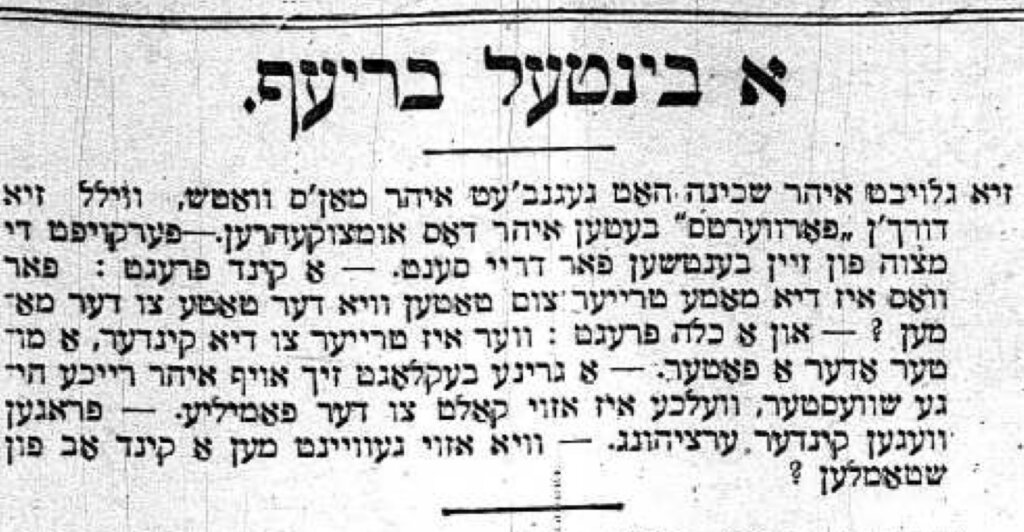
January 20, 2026 marks the 120th anniversary of A Bintel Brief, the Forward’s advice column, launched in 1906 by the paper’s founder and publisher, Ab Cahan. Tackling the personal challenges of Eastern European Jewish immigrants, Cahan and the Bintel Brief columnists who followed him would dispatch their advice with humor, compassion, and honesty.
By 1906, Der Forverts, as the Forward is known in Yiddish, had grown over its initial three decades to become the leading Yiddish-language newspaper in the United States. But A Bintel Brief — Yiddish for “a bundle of letters” — was something the paper hadn’t tried before. Well, not exactly.
In his introduction to the very first Bintel Brief, which is preserved online at the National Library of Israel, Cahan explained that the new column had been inspired by a section of the paper devoted to letters to the editor that launched three years earlier.
A Bintel Brief, however, would be an advice column, focusing on letters “that expressed issues of … human interest,” Cahan explained. He continued, “Readers will find in the Bintel Brief letters an interesting turning of pages from the Book of Life … Hundreds of diverse emotions, interests and lost opportunities will be expressed here. Hundreds of various vibrations of the human heart will be heard here.”
History would prove him right. Over the next 120 years, A Bintel Brief would explore the “various vibrations of the human heart” with homespun Jewish advice, tens of thousands of times over, and along with its contemporary advice columnists like Dorothy Dix inspire countless advice columns across U.S. newspapers, including “Dear Abby” and Ann Landers (née Esther Friedman).
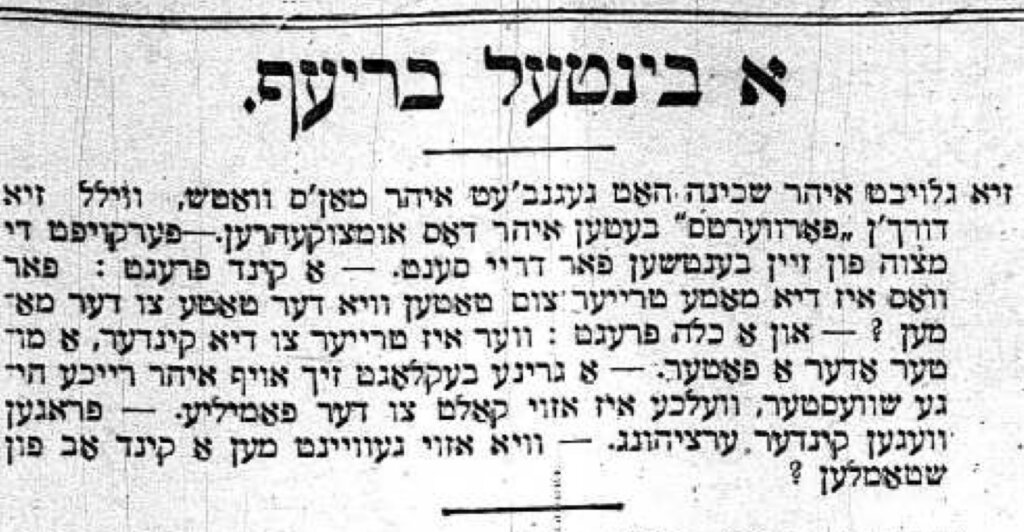
In his autobiography Pages from My Life, which Cahan published 100 years ago in 1926, he recalled, “I had always wished that the Forverts would receive stories from ‘daily life’ — dramas, comedies or truly curious events that weren’t written at a desk but rather in the tenements and factories and cafés — everywhere that life was the author of the drama … How to do this? Not an easy task — much harder than writing an interesting drama or comedy.”
“One day in January 1906,” he continued, “[my secretary, Leon] Gottlieb told me about three letters that had arrived which didn’t seem suited for any particular department … All three letters were of a personal nature rather than a communal one, and each told an individual story. I considered the three letters and my response was: Let’s print them together and call it A Bintel Brief.”
There’s also the apocryphal version of the story, illustrated by cartoonist Liana Finck while working on a series of cartoons inspired by A Bintel Brief that eventually became a book in 2014. “Rumor has it, the letter on the top of the pile Abraham Cahan’s secretary brought him that strange day in 1906 was two feet long and sewn together with scraps of industrial thread. The spelling was atrocious, but the tears that spewed out of the letter were real — Cahan tasted them to make sure.”
While perhaps nothing more than a mayse, the story rightly captures the willingness of Forverts readers to share their individual problems with A Bintel Brief and seek advice.
And some of them still resonate today.
For example, in the first edition of the column, a bride-to-be reached out because of a debate that erupted with her fiancé after she suggested that mothers are more faithful to their children than fathers because they are the ones saddled with the responsibility of childcare, to which the fiancé angrily replied that women make too big of a deal of their role as caregivers, and that fathers are more dependable. Cahan replied that “smart, serious minded parents raise children that are both truly loyal and have both feet on the ground” like the mother and father. To this, he added, “It’s best for your future children that you read all you can, attend as many lectures as possible, and develop together and grow intellectually. That will create a pair of parents who best know how to raise their children and will be of service in their devotion and love.”
It also did not take long for questions regarding interfaith relationships to emerge in the column. One letter that same year featured a newlywed Jewish man describing the fraying relationship with his Christian wife over the first year of marriage. “Mixed marriage between a Gentile and a Jew is a complicated affair,” Bintel acknowledged, before putting a spin on the then-common story of Jewish parents sitting shiva for their son marrying a Gentile woman: “Not enough has been said about the Gentile family. For while the parents of the Gentile girl may accept the Jewish son-in-law and tolerate the marriage, the girl loses many of her friends, former classmates and relatives.”
Writing for the Forward in 2014 about Finck’s book, Yevegeniya Traps noted that letters like these offered “a succinctly potent representation of the lives of Eastern-European immigrants trying to make their way in early-20th-century New York.” She added, “No artist or journalist could render the doubt, uncertainty and backbreaking work of life in the New World as clearly and honestly as the words of sufferers seeking wisdom” from A Bintel Brief.
Or as Cahan concluded in his autobiography, “Everyone wrote about that which was closest to their hearts. The result was that the Bintel Brief would be assembled out of those letters that revealed the most interesting nooks of people’s souls.”
The post How ‘a bundle of letters’ became a cornerstone of life advice for American Jews appeared first on The Forward.


